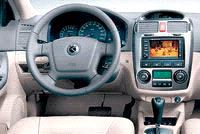Inkjet & Digital Printing
FIT TO DRIVE

Monday 24. March 2014 - FDM Dashboard Prototype Holds Tight Tolerances; Improves Design
Korean-based Hyundai Mobis makes original and aftermarket equipment for the automotive industry, including Hyundai and Kia. In its drive to be best in class and a global top 10 supplier, it depends on prototyping for design verification, airflow evaluation, and functional testing. The company uses a Fortus FDM (fused deposition modeling) system for components such as instrument panels, air ducts, gear-frame bodies, front-end modules, and stabilizer-bar assemblies.
Real Solution
Consumers judge the quality of a vehicle on many factors, but none is more important than component fit and finish. Using rapid prototypes, Hyundai Mobis evaluates the smallest details to ensure the fit conveys a sense of quality. The design verification of an instrument panel for Kia’s Spectra demonstrates this commitment to detail. The instrument panel exceeded the large build area of the company’s Fortus system, so it was modeled in four pieces and assembled to measure 498 x 454 x 1382 mm (20 x 18 x 54 in.).
Before installing the instrument panel model in a cockpit assembly, the design team mounted it on a fixture and scrutinized it with a CMM (coordinate measuring machine), and captured hundreds of measurements. According to Tae Sun Byun, principal research engineer for the Hyundai Mobis Auto-Tech division, “Dimensional accuracy and dimensional stability were critical for the design verification. The FDM system, with its ABS plastic, gave us both. Over a length of 1382 mm, the greatest deviation was just 0.75 mm.”
Mounted in the cockpit mock-up, the instrument panel revealed 27 design flaws. Although all were minor, collectively the errors would have added cost and delayed the project. “The prototype allowed us to find design issues that were challenging to see in 3D CAD,” says Mr. Byun. “When the FDM part was combined with mating components and subassemblies, the design flaws were quickly detected and repaired.” As a result of this attention to detail, Kia has garnered accolades from Car and Driver magazine, which wrote of the Spectra “…its interior fit and finish is premium.”
In addition to the tight modeling tolerance of the Fortus system, Hyundai Mobis also values its other advantages. “It gives us the durable parts we need for assembly and functional testing,” says Mr. Byun. “And it’s easy to use. The water-soluble support structure is very important due to our time pressures. Without this, a complex component like the instrument panel would take us many hours, if not days, just to post-process.”
Hyundai’s Fortus system has been operating at 91 percent of capacity – roughly 8,000 hours per year – yet the company has been outsourcing 60 percent of its prototyping work. Outsourcing increases delivery time and decreases the number of design iterations, so the company plans to install a second prototyping system. Although there are many options, the company will install another Fortus FDM system. Says Mr. Byun, “It’s perfect for our design needs, and the first one paid for itself in under 30 months.”
